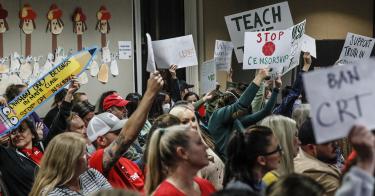Today, in Part I of this essay, I explain critical race theory and show how many of its ideas have made their way into public schools across the country, prompting a backlash that has led to the introduction of anti-CRT education regulations in many states. CRT views values like “objectivity” as tools of oppression. It’s clear that many public schools are indeed incorporating plenty of CRT-inspired ideas like these in their curricula.
Do the rights of parents to direct the education and upbringing of their children end at the schoolhouse door? That’s effectively what the Ninth Circuit decided in Fields v. Palmdale School District, a 2005 case in which parents argued that the school district violated their rights by giving elementary school students a questionnaire that included sensitive sexual topics, without parents’ knowledge or consent. The Ninth Circuit ruled against the parents, stating that parents’ right to control their children’s education—a right long recognized in common law and explicitly affirmed by the Supreme Court in Meyer v. Nebraska and Pierce v. Society of Sisters—“does not extend beyond the threshold of the school door.”
This position was taken more recently by Virginia gubernatorial candidate Terry McAuliffe. His statement on this matter in the October debate—“I don’t think parents should be telling schools what they should teach”—arguably ended up losing him the election. McAuliffe’s statement was in answer to a question about bills he had vetoed as governor requiring parents to be notified about sexually explicit content in the curriculum. While sex education remains a contested issue, the focus of many parents’ concerns in Virginia and throughout the country has now shifted to a new topic: critical race theory (CRT).
Today, in Part I of this essay, I explain critical race theory and show how many of its ideas have made their way into public schools across the country, prompting a backlash that has led to the introduction of anti-CRT education regulations in many states. Tomorrow, in Part II, I explain why teaching CRT-inspired ideas in public schools is contrary to parental rights; I propose school choice as a crucial part of the solution.
What Is Critical Race Theory?
Critical race theory has its roots in the Critical Theory of the neo-Marxist Frankfurt School, developed by thinkers such as Max Horkheimer, Theodore Adorno, and Herbert Marcuse, and continued in the work of Jürgen Habermas and others. Questioning both the value and the possibility of objective knowledge, and seeing claims to universal truth as the seeds of oppression, Critical Theory as defined by Horkheimer aims at the practical goal of human “emancipation from slavery,” particularly slavery to repressive ideologies embedded in dominant social structures (including, but not limited to, capitalism).
CRT grew out of the Critical Legal Studies movement of the 1970s and 1980s, a version of Critical Theory that argued that law is not truly impartial but a means by which elites maintain power and privilege. Critical race theorists such as the late Derrick Bell, Kimberlé Crenshaw, and Richard Delgado drew on this general approach, but shifted their focus from social class to race, extending their critique beyond the legal arena.
Although critical race theorists’ views differ widely, there are a number of key tenets to CRT. Central among these is the claim that racism in the U.S. is pervasive and embedded in social structures, not an aberration from the norm or limited to the actions of a few racist people. As a result, values like legal neutrality, objectivity, color-blindness, and meritocracy are viewed with suspicion. These principles are seen as means of perpetuating inherently racist legal, social, and economic systems.
Progress in racial justice—such as the outlawing of racial discrimination in the Civil Rights Act of 1964—only occurs, according to CRT, when it happens to advance the self-interest of white elites. “Objectivity” is viewed as a tool of oppression—a conceptual thread that runs through all the various versions of critical theory. Skepticism of objectivity leads CRT to emphasize the experience of racial minorities through qualitative research methods such as interviews and autobiography.
Especially through the work of Kimberlé Crenshaw, CRT extends beyond concerns with racial inequality to consider how race, class, gender, disability, sexual orientation, etc. are all axes of oppression that intersect in a variety of complex ways. Thus, for instance, a poor black woman will be disadvantaged by more axes of oppression than will a wealthy black man. This conceptual approach is often referred to as “intersectionality.”
The academic work of CRT scholars has been popularized by the writings and training programs of such celebrity “anti-racism” figures as Robin DiAngelo, author of White Fragility, and Ibram Kendi, author of How to Be an Anti-Racist, to name just two.
Kendi has been invited to speak (and paid quite handsomely with taxpayer money) at many schools across the country, including Evanston, Illinois, Fairfax, Virginia, and Charlotte, North Carolina. DiAngelo’s and Kendi’s books and ideas—like the claim that all whites are inherently privileged and part of a system of white supremacy, or that unless you are actively pursuing an “anti-racist” agenda you are a racist—have been widely incorporated into teacher trainings and school curricula (such as the curriculum of Albemarle County, Virginia schools, detailed below).
Another popular outgrowth of CRT that has significantly influenced American education is the New York Times’ 1619 Project. This project is a rewriting of United States history in which the founding and history of our nation are portrayed as essentially based upon racism and slavery. In the project’s lead essay, for instance, Nikole Hannah-Jones claims that a primary reason for declaring independence from Britain was “to protect the institution of slavery,” and thus that “this nation was founded not as a democracy but as a slavocracy.” Widely criticized and debunked by eminent scholars such as Allen Guelzo and Peter Wood, the project has nonetheless been highly influential, and provides free curricular materials that have made their way into schools across the country.
CRT in Schools
This brings us back to current controversies regarding the teaching of “critical race theory” in schools. I use quotation marks here because school representatives often try to dodge criticism by denying that critical race theory is being taught. For instance, Brenda Sheridan, chair of the school board in Loudon County, Virginia, stated that CRT is not part of the curriculum, explaining, “It is a graduate-level theory, and it would be inappropriate if a fifth-grader was doing that.”
Yet these denials clearly miss the point. Concerned parents objecting to CRT in schools are not claiming that public school teachers are discussing the writings of Crenshaw or Delgado with their elementary school students (though the works of critical race theorists are explicitly used in teacher’s trainings). Rather, even where CRT is not explicitly referred to in the curriculum (as it is in many cases), parents object to things like the insertion of “diversity, equity, and inclusion” lessons that incorporate or apply the key tenets of CRT, or the teaching of revisionist history along the lines of the 1619 Project. Whether or not this actually amounts to “teaching CRT” is irrelevant; what’s important is not the label, but the substance of what is being taught.
And it’s clear that many public schools are indeed incorporating plenty of CRT-inspired ideas in their curricula. Consider, for instance, the Albemarle County School District in Virginia, which adopted an anti-racism policy in 2019. The details of the policy and related curriculum are documented in the official complaint filed in C.I. v. Albemarle County School Board, a lawsuit brought by five families who object to the ideology being taught in their schools.
According to the complaint, the county’s schools teach children that all “whites” are inherently privileged due to their race, while all people of color are inherently disadvantaged and subordinated—echoing core ideas in the work of DiAngelo, Noel Ignatiev, Cheryl Harris, and others, and CRT’s central claim about the systemic and pervasive nature of racism in our country. One article used in the curriculum states that in order to avoid being racist “white people . . . must acknowledge and understand their privilege,” while people of color must “recogniz[e] how race and racism have been internalized.” Students are told that being opposed to affirmative action, claiming reverse discrimination, saying “we all belong to the human race,” or seeking objectivity by recognizing that there are “two sides to every story,” are forms of racism.
This curricular content clearly draws on (and oversimplifies) CRT’s view of legal neutrality and objectivity as tools of oppression that perpetuate systemic injustices. Similarly, in what could be a summary of key take-aways from CRT popularizers like DiAngelo and Kendi, a student handout presents a wide variety of actions and attitudes—including being “colorblind,” the “celebration of Columbus Day,” “denial of white privilege,” support of “anti-immigrant policies,” and “over-familiarization with POC [people of color]”—as “passive racism” that directly supports more “active” racist actions like “hate crimes” and “lynching.”
>>> How the Grassroots Are Resisting CRT
The curriculum does not limit the teaching of such ideas to a single course, but requires that they be incorporated into multiple subject areas, including English, social studies, science, and even math. Crucially, these ideas are not presented as offering a controversial perspective that students can discuss and critique. On the contrary, this ideology is presented as uncontested truth to which students must assent and conform. The punishment for failure to do so is not only being labeled racist, but official disciplinary actions such as detention, suspension, or the requirement to attend a “restorative justice” session. Teachers are also forced to teach these ideas regardless of objections and can be disciplined for expressing dissenting views “antithetical to School Board values” on their private social media accounts.
Albemarle School District is just one example among many. Policies and curricula like this one are being aggressively promoted by national educators’ associations and included in school districts around the country.
In response, many state legislatures have passed or proposed bills attempting to stop schools from indoctrinating students in CRT-inspired ideology. According to the free expression group PEN, as of mid-December 2021, sixty-six such bills had been introduced in twenty-six states. Ten states have enacted such legislation, and over thirty bills are pending or have been pre-filed for 2022.
While this legislative strategy is controversial, it may be the only realistic way to address this problem, at least in the short term. Furthermore, carefully crafted bills (like this one) would actually protect free speech (by ensuring that no student or teacher is compelled to affirm the tenets of CRT), rather than stifling classroom discussion as critics fear.
At the same time, however, we need to start thinking more seriously about another foundational, long-term solution: school choice. That will be the subject of Part II of this essay, to be published tomorrow.
This piece originally appeared in Public Discourse





